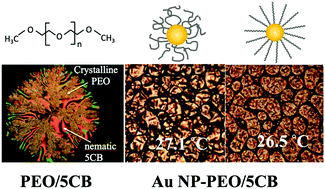Polymer functionalized nanoparticles in liquid crystals: combining PDLCs with LC nanocomposites†
Abstract
Liquid crystal (LC)–polymer blends are important stimuli responsive materials already employed in a wide range of applications whereas nanoparticle (NP)–LC blends are an emerging class of nanocomposites. Polymer ligands offer the advantages of synthetic simplicity along with chemical and molecular weight tunability. Here we compare the phase behavior of 5CB blended with poly(ethylene oxide) (PEO) and with gold NPs functionalized with thiolated PEO (AuNP–PEO) as a function of PEO concentration by DSC, POM and 13C NMR spectroscopy. Both PEO and the AuNP–PEO form uniform dispersions in isotropic 5CB and phase separate below the I–N phase transition temperature. Above the PEO crystallization temperature, the PEO/5CB blends show the expected biphasic state of PEO rich-isotropic liquid co-existing with PEO-poor nematic droplets. At PEO concentrations above 10 wt%, nematic 5CB nucleates with PEO crystallization. Both PEO and AuNP–PEO induce homeotropic alignment of the 5CB matrix immediately below TNI. The AuNP–PEO/5CB blends form thermally reversible cellular networks similar to AuNPs functionalized with low molecular weight mesogenic ligands. A thermodynamic model to account for the observed phase behavior is presented.



 Please wait while we load your content...
Please wait while we load your content...